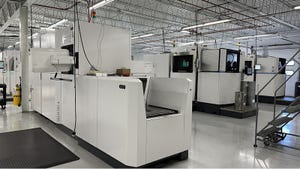April 29, 2004

They won't be UFOs. And the strange objects appearing over Columbus, GA later this summer won't be top secret military aircraft. They will be the latest models of the AeroSphere-a spherical airship superficially akin to a powered balloon-built by Techsphere Systems International, www.techspheresystems.com. The company is hoping to develop the technology into unmanned vehicles serving as sensor platforms and communications relays for both civilian and military uses.
The R&D firm 21st Century Airships www.21stcenturyairships.com designed the craft. Techsphere builds the vehicles and has contracted the Georgia Tech Research Institute to provide engineering integration expertise for automation of the airships. Techsphere will also furnish AeroSpheres to the U.S. Army Soldier Battle Lab at Ft. Benning, GA for testing.
The initial, "small' diameter versions, about 60 ft across, will fly best from 10-15 thousand feet altitude, carrying a 1,000-lb payload for up to 72 hours. Next out the door this summer will be 90-ft models to carry a similar payload to between 25-30 thousand feet. The largest airship envisioned thus far, according to Techsphere President Mike Lawson, is a 300-ft diameter behemoth slated to roll out next year and targeted at 30-60 day missions carrying 4,000 lbs to 60-70 thousand feet.
Power and control
Depending on the size, three to five pivoting propellers, roughly around the equator of the sphere, provide horizontal and vertical propulsion as well as attitude control. Lawson also points out that unlike cigar-shaped airships, such as blimps that use airfoils, which must have air moving over them to exert control forces, the peripheral propellers provide three-axis control moments and forces even when the craft is motionless in the air. This characteristic also allows for a controlled, vertical landing with minimal ground crew. And because a sphere has the lowest surface area per unit internal volume, the AeroSphere as a lower leakage rate of buoyant helium gas through its surface.
Initial AeroSpheres use turbodiesel driven generators to provide electric power to the propeller motors. Eventually fuel cells in concert with solar cells on the outside of the sphere or possibly hydrogen-based generators will be used to furnish electric power for long duration missions.
Inside story
While it may resemble a balloon in shape, the AeroSphere has important differences besides having propulsive power. It has two envelopes-the first, inner helium envelope is initially filled to only about 6 percent of the fully expanded volume. This is suspended from the top of an outer shell made from Honeywell Spectra 1000, a Kevlar-like mesh selected for strength and UV resistance. In the smaller AeroSpheres the outer envelope has no solid structural members, being slightly pressurized to maintain a constant spherical shape. The larger, high-altitude versions will use a modular composite-tube frame for added support and strength. As altitude is gained, the inner gas bag expands to fill the spherical volume at its operational altitude.
Lawson notes a design challenge was determining the locations of the gimbaled props on the surface of the AeroSphere for minimum drag. He adds the developers intend to introduce a patent-pending arrangement of "smaller engines" on the vehicle, which will modify the air flow and boundary layer around the craft to further reduce drag.
For future developments, Lawson talks about an around-the-world flight with a manned 130-ft version for 2005. This airship will be configured to fly between 25 and 40 thousand feet to take advantage of the highest winds aloft in the tropopause at about 30 thousand feet-a region the craft would usually avoid when station keeping over a spot on the ground. Finally, he says, in five years, AeroSpheres could be flying as communication links in developing areas of the world, deployed to fill "dead spots" in our own telecom network, and even serving in surveillance missions over U.S. ports and borders.
|
|
|
|
About the Author(s)
You May Also Like







